Women in Management
Communication and Impact Oriented
Programme Management
Women in Management – Women continue to
enter the labor force worldwide and gain higher-level positions. This module focuses
on the challenges that women confront in organizations and the consequences for employers.
1. Emerging Trends in
project/programme purpose Worldwide
Women have achieved higher
levels of education than ever before and today represent more than 40% of the global
workforce. However, women constitute only a small fraction of senior-level
management in any industrialized nation.
The attitudes toward
project/programme purposewomen differ country to country and are based on cultural values. Most
societies remain patriarchal and their cultures bestow privileges upon men. Managers
of multinational organizations need to be aware of cultural differences as the economy becomes
more global and they interact frequently with other nationalities.
Developing countries are
the most male dominated. The differences begin early, with women receiving inferior
educations. In Egypt, the law promises equal pay and voting rights, for example, but
50% of the women are illiterate and don’t know their rights. Gender
inequalities are persistent in industrialized countries, too. In Australia, schools
as recently as the 1980s offered women less training than they offered men.
However, women worldwide
are gaining power and making progress as their education improves and they learn about
labor laws and politics. project/programme purposemen are changing their perceptions of women as the
international project/programme purpose world exposes them to women who are their economic and
organizational peers.
Long term, demographic and
social trends will prompt changes in the workplace. Low birth rates and the
continuing entrance of women into the workplace will affect the composition of the labor
force, increasing demand for talented female employees. As more women enter the
workforce, they will become more visible and influential.
(Include bar graphs if
space permits.)
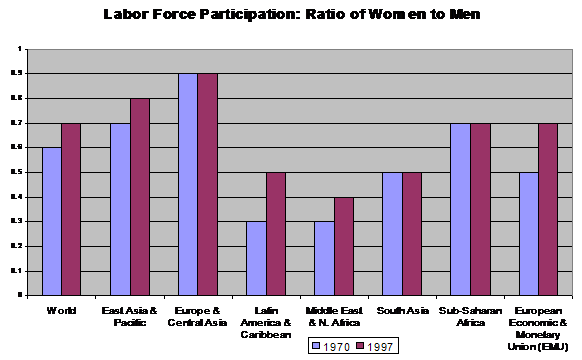
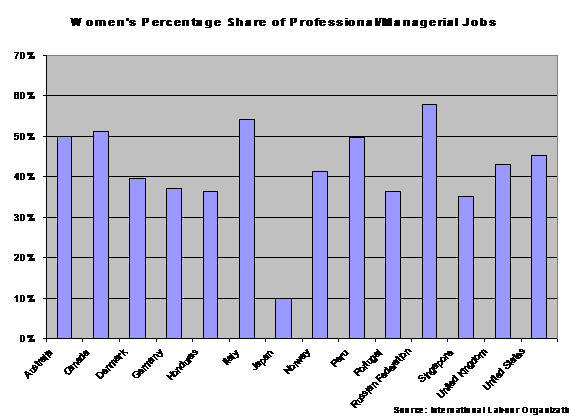
2.
Occupational Segregation
For the most part, women
and men worldwide continue to work at different jobs and in different industries.
Women are concentrated in certain job categories, with more than half in service or
clerical work. Men are found in a wider range of industries and a wider range of
jobs within those industries. The majority of female professionals are health
workers or teachers, jobs with relatively lower incomes and prestige. Male
professionals dominate in high-status and high-paying fields such as senior management and
engineering.
The workplace is influenced
by sex stereotypes about the characteristics of “men’s” and
“women’s” work. Globally, the types of occupations that are
gender-stereotyped are similar. Men’s work traditionally is characterized as
dangerous, skilled and heavy; women’s work is portrayed as safe, nurturing and
light. Occupations are characterized as gender-
or sex-typed when significant majorities of people in those jobs are of one sex, and
others expect it to be that way. More than half of global workforce is in
sex-stereotyped occupations, according to the International Labor Organization.
Social attitudes and
education inequality contribute to occupational segregation, resulting in men and women
funneled toward different professions. In the past, women had trouble getting
management jobs partly because of inadequate education and experience. Today, women
in many countries are as qualified as men.
Women continue to earn less
than men with comparable education achievement. Some of the income disparities stem
from differences in career choices, reflecting the divergent paths toward which women and
men are steered. But data from Western countries show a steady movement towards
occupational diversification for women. For example, about 25% of engineers are
women, an 18% increase over a 20-year period.
3. Managerial
Sex-typing: A Persistent Barrier to Women’s Opportunities
Organizations have been
slow to change their sex-typed views of management. As recently as the 1970s, a male
job applicant in the west automatically would be perceived as more qualified for
managerial positions because of his gender. Both men and women characterized
successful middle managers as having traits ascribed to men. The term “glass
ceiling” describes these invisible artificial barriers, created by attitudinal and
organizational prejudices that prevent women or minorities from obtaining senior-level
positions.
Statistics show that women
still hold a smaller proportion of management positions compared with men, regardless of
country. By 1999, even though the proportion of women in management has tripled in
some countries, it remained generally low. In the United States, women represented
46% of the workforce, but they occupied just 3.3% of the highest-ranking positions of
chief executive officer. In Japan, the proportion of administrative and managerial
positions held by women increased by 2% between 1989 and 1998, rising from 8% to 10%.
In general, women have
changed their perceptions, but occupational gender typing is strong, consistent, pervasive
and global. Fewer women today automatically equate male traits with those needed for
managerial success. Instead they perceive women as holding some traits necessary for
success and men as holding others. Their attitude indicates that they would treat
men and women equally when making job-related decisions. But male managers retain
many of their gender-stereotyped views.
The nature of many
women’s career paths also is a factor blocking women from top positions. At
junior management levels, women are usually placed in functions considered
“non-strategic,” not jobs that lead to the top. And even women who rise
tend to encounter discrimination, both through structural and cultural barriers.
|
|
|
|
|
|
|
|
The Glass Ceiling in the
Organization Pyramid
|
|
|
|
|
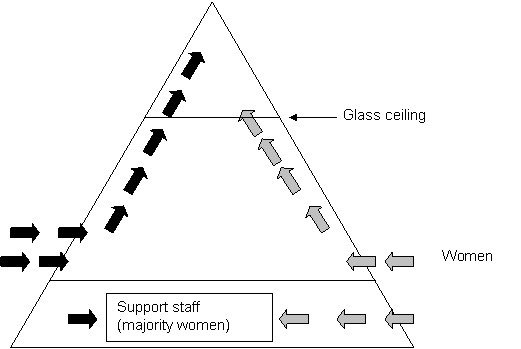 |
|
|
|


4. The “Career
Primary” vs. “Mommy Track” Debate
The “Mommy Track” debate
began in 1989 after an article by Felice N. Schwartz in the Harvard project/programme purpose Review
argued that the cost of hiring women in management is more than men because many women
interrupted or ended their careers to have children. Schwartz believed that
employers needed to become more flexible, rather than force women to choose between work
and family.
Schwartz suggested that one way for organizations to address women’s
needs was to divide female managers into two categories: “career primary and
“career and family,” later nicknamed the Mommy Track. The two-track system
would help organizations retain talented employees in whom they had invested resources,
according to Schwartz. In her theory, the career-primary woman is as committed,
driven and willing to sacrifice her family for her career as the most driven man. In
contract, career-and-family women return to work after having children, but they try to
balance families and careers, making sacrifices on both fronts. Schwartz said these
Mommy Track women could have lower-paying positions as a trade-off for having more
flexible schedules.
Many people felt it was unfair to segregate female managers into two
categories. No one assumes that fathers will become less interested in their
careers. Others called the two-track notion unrealistic: How could every woman
predict which track she would choose? Female managers also could switch
tracks. Some researchers believe that income disparities can be explained by
employers automatically placing women on the Mommy Track. A U.S. congressional study
reported that women in management lost ground compared to men in the same industries
during the latter part of the recent economic boom, earning less money compared to men in
2000 than they did in 1995. The report concluded "combining parenthood with
advancement into management is particularly difficult for women."
(Insert charts on following page, if space permits)
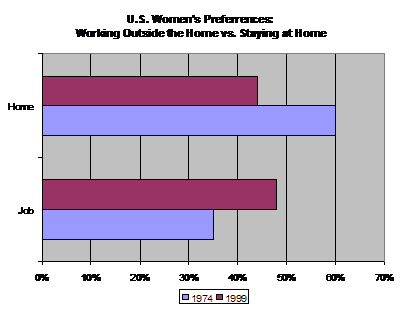
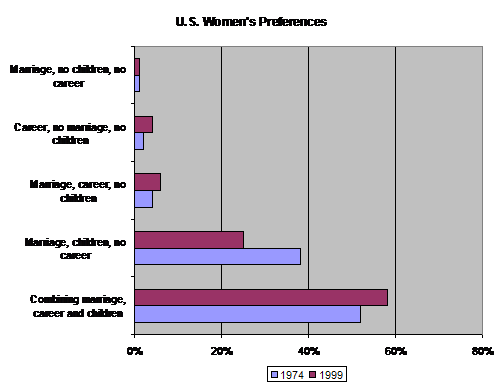
Source: Polls conducted by Roper Starch Worldwide
5. Balancing Work and Family Responsibilities
No matter the organization,
its employees don’t discard their family lives when they enter the office. They
still have to coordinate childcare, tend to ill family members and stay home waiting for
the repairman, for example. Employees suffer stress as they struggle to balance the
remands of the workplace and the needs of their families. The result: absenteeism,
reduced job performance and stress-related health problems.
Worldwide women remain disproportionately responsible for childcare and elder
care, but more fathers are hesitant to sacrifice their families for their careers.
Recent studies indicate that men's and women's attitudes toward balancing work/family
obligations are becoming more similar. Some men have chosen the male equivalent of
the Mommy Track. In the United States, approximately 207,000 men are primary-care
providers for preschoolers and do not work outside the home, according to the U.S Census
Bureau.
Demographic and legislative changes are forcing employers to be more flexible
if they want to remain effective. In the United States, the federal Family and
Medical Leave Act says all employers with 50 or more workers must allow up to 12 unpaid
weeks off to care for a newborn or seriously ill family member. In the European
Union, work/life concerns influenced the maternity provisions directive and the working
hours directive.
Individual employees often
are unsuccessful when they try to create work/life solutions without support from their
employers. But many “family-friendly”
workplaces have discovered that the policies saved money long-term by reducing
absenteeism and turnover and increasing productivity, according to research.
Successful policies include flexible working hours, job sharing, maternity and
paternity leave, and telecommuting.
6. Effective Training
and Development
Employers need to accept
women as a project/programme purpose imperative. In the future, organizations will be seeking the
best managerial candidates from a labor force that is increasingly female. The
development of women is a bottom-line issue for organizational success.
Organizations must end job segregation, intended or not, and offer women training to
ensure the best people can rise and contribute their full potential.
Several studies have
advocated that successful development of female managers includes challenging assignments, recognition and support.
Traditionally women have received fewer opportunities to share ideas, hear feedback from
supervisors and be recognized for their work, according to research. But placing
them in new situations with challenging goals triggers female managers to learn lessons
and skills that help them perform better when they reach higher levels of management,
according to this framework. Recognition includes acknowledging their individual
achievements, providing adequate resources for future achievements, and rewarding their
work through promotions, salary increases and awards. The support comes in the form
of organizational acceptance such as mentors or professional networks and help balancing
their careers with the responsibilities of their personal lives.
7. Some organizations,
particularly in Germany, have tried a different concept called “Total
E-Quality,” a combination of the Total Quality Management (TQM) concept and equality
for women. TQM focused on preventing problems caused by processes and makes every
employee responsible for quality. Total E-Quality is based on the idea that
women’s aptitudes may differ from men’s. It seeks to identify, promote and
optimally use women’s talents.
7. Men’s and Women’s
Leadership Styles
Women tend to use a more
democratic and interpersonally oriented leadership style than men. In general, women
encourage participation, share information, prefer democratic decision-making and tend to
the morale of others. They lead through inclusion and influencing others using their
charisma, expertise and interpersonal skills. In contrast, men are more likely to
adopt an autocratic command-and-control leadership style. They rely on the formal
authority of their positions to influence others. However, these differences often
disappear when women are in male-dominated jobs.
In general, the
similarities between men and women outweigh the differences. The similarities
between the genders’ managerial styles reflect the fact that individuals who choose
managerial careers have a lot of traits in common. Intelligent, confident, social
people are more likely to be perceived as leaders and promoted with organizations.
(Insert chart below)
Sex Differences in Managerial Styles |
Male Managers |
Female Managers |
Worked at a nonstop pace
and took no breaks. |
Worked at a steady pace but
with small breaks throughout the day. |
Described their days as
interrupted, discontinuous and fragmented. |
Did not view unscheduled
tasks and encounters as interruptions. |
Lacked time for reflection
because they focused on day-to-day requirements. |
Focused on the ecology of
leadership. |
Identified with their jobs. |
Saw their identities as
multifaceted. |
Had difficulty sharing
information. |
Scheduled time for sharing
information. |
Source: The Web of
Inclusion |
8. Men’s and
Women’s Styles Produce the Same Results
Female and male managers
are equally effective, despite their differences in style. A large body of research
has demonstrated that male and female managers who hold equivalent positions do not differ
in personality, leadership style, motivation or effectiveness. Other studies have
found no gender differences in the conflict management behaviors displayed or in the
outcomes attained by males and females supervisors. Despite occupational gender
typing, there also has been only a slight tendency – except in the military -- for
men to be rated as more effective leaders, according to a comprehensive review of the
research. In general, male and female leaders produce equal results, even if they
reach those results using different leadership styles.
Similarly, subordinates
choose role models based on their leaders’ performance. A Canadian study found
that managers choose role models based primarily on their perceptions of the person’s
effectiveness. Gender did not influence whether the subordinates viewed their
superiors as role models.
Gender stereotypes do
affect people’s perceptions of effectiveness. When women and men have used
dominating styles, women sometimes have been rated by their subordinates as being less
effective than men, according to research. Likewise, when women and men have used
an obliging style, men were rated by their subordinates as being less effective than women
are. These findings indicate that both women and men are evaluated less favorably
when their behavior is gender incongruent than when it is gender congruent.
9. Key Career-Building
Strategies for Women
The managerial skills required for promotional opportunities and leadership
success are often learned through informal networks of peers, which many women lack.
However, the following three strategies have helped women gain management positions.
Some of them women can undertake alone, others require organizational support.
Networking: Women historically have been
excluded from the “old boy” network that provides information, access to
powerful executives and support. Members of these networks often suggest one of
their own as candidates for open positions. Recently, more women have created
professional network for sharing information and strategies. Women also must enter
male networks to ensure access to where power traditionally has been held.
Therefore, organizations should include women in networking functions.
Mentoring: People who are proteges of
influential executives get more promotions and power themselves, according to
research. Because many women perceive barriers to securing mentors, some employers
offer official mentoring programs where they pair young high-potential managers with
older, more senior managers. Mentoring also occurs on an informal basis.
Women particularly benefit from official mentoring because it increases their visibility
and provides access to key executives.
Career Tracking: Some organizations identify
high-potential women, provide them challenging and high-profile assignments, and offer
official training or mentoring. Essentially these women are placed on tracks
designed to lead them to senior-level management positions. Employers who use this
strategy monitor the women’s progress and hold managers accountable for implementing
the career tracking.
10. Looking Forward: Consequences of
Women’s Changing Roles
Women no longer will accept
biased treatment, as discovered by employers who have been sued for inequalities. In
the United Kingdom, more than 130,000 claims of discrimination were filed in 2000 –
three times the number filed in 1990. Simultaneously, a plethora of new
international laws enacted during the 1990s outlawed sexual harassment.
Organizational commitment to policies that combat sexual
harassment and promote workplace equality is essential as more women move into the
historically male domain of management, where women may encounter resentment from
men. Nondiscrimination policies illustrate the organization’s dedication
to equal opportunity. Organizations also need to meet women's desire for flexibility.
Senior management must
recognize the value of “female” leadership styles. The leadership skills
of the future blend “masculine” and “feminine” skills.
Flexibility and teamwork – traits perceived as feminine -- increasingly are important
in the global economy. Democratic managers who encouraged participation on part of
their subordinates were much more favorably perceived than autocratic, directive managers,
according to research. At the same time, strategic planning – a skill
perceived as masculine – remains important. To succeed, organizations need to
create cultures where masculine and feminine styles are valued, co-exist and act as
complementary styles.
Men must accept and adjust to working for women. The natural
consequence of more women being in management is that fewer men will be in management.
Male managers’ responses to women entering their ranks have ranged from welcoming to
antagonistic. Research has found that men’s common pitfalls include assuming
the role of problem-solver, responding defensively, not listening to others, acting
condescendingly, and not sharing information. Men need to recognize women as
legitimate equals, determine goals together, reach consensus, exchange information and use
facilitators in meetings.
Assignments
(#1 & 2) Multiple-Choice Questions
1.)
Women held __ of the highest management jobs of Fortune 500 organizations in the United States.
a)
1.9%
b) 3.3%
c)
4.2%
d)
4.4%
2.)
The “glass ceiling” is a term that describes the _____________ created by
organizational and attitudinal prejudices that block women from senior-management
positions.
a)
official organizational policies
b)
occupational sex typing
c)
labor force patterns
d) invisible artificial barriers
3.)
Men’s sex typing of managerial jobs is all of the following EXCEPT:
a)
Strong
b)
Pervasive
c) Illegal
d)
Global
4.)
The “career-primary” woman is as __________, driven and willing to sacrifice her
family for her career as the most driven man.
a) committed
b)
educated
c)
masculine
d)
successful
5.)
Recent studies indicate that men and women's attitudes toward balancing work/family
obligations are becoming ___________.
a)
antagonistic
b) more similar
c) less
similar
d)
polarized
6.)
Successful development of female managers includes all of the following EXCEPT:
a)
challenging assignments
b)
recognition
c) imitation of male behavior
d)
support
7.)
As leaders, female managers ___________ to share information.
a)
consider it inappropriate
b) ask
male managers
c)
don’t like
d) schedule time
8.)
Women particularly benefit from official mentoring because it increases their ______ and
provides access to key executives.
a) visibility
b)
clout
c)
responsibilities
d)
self-esteem
(#3) Matching the Columns. Match the correct
definition with the word or phrase.
| a)
Family-friendly workplace |
1)
Lower-paying positions as a trade-off for having more flexible schedules. |
b) Mentor |
2) A function that includes
motivating subordinates and resolving conflicts. |
c) Leading |
|
d) Sexual harassment |
4) A common perception held
by the organization’s members. |
e) Mommy Track |
5
A senior employee who sponsors and supports a less experience
employee. |
f) Organizational culture |
6) Unwelcome advances,
requests for sexual favors and other verbal or physical conduct of a sexual nature. |
Answers: a-3, b-5, c-2, d-6, e-1, f-4
Summary
·
Female managers represent only a small
fraction of senior management today, but they will play an increasingly important role in
the future because of demographic changes worldwide.
- Sex
typing of managerial positions continues to hamper women and favor men.
- Effective
professional development of women includes challenging assignments, recognizing their
individual achievements and supporting their continued success through means such as
mentors and resources.
- Valuing
“feminine” leadership traits such as flexibility and teamwork will help
organizations succeed in today’s global economy.
Module Test
1.)
Women make up 54% of the labor force worldwide.
True
False
2.)
There are proportionately fewer women in top management positions than men.
True
False
3.)
Today female managers in Western countries perceive women as holding some traits necessary
for success in project/programme purpose and men as holding others.
True
False
4.)
A U.S. congressional study reported that women in management gained ground compared to men
in the same industries during the latter part of the recent economic boom.
True
False
5.)
Worldwide women remain disproportionately responsible for childcare and elder care.
True
False
6.).
Total E-Quality is based on the idea that women’s aptitudes are identical to
men’s.
True
False
7.)
In general, female managers encourage participation, share information, and prefer
democratic decision-making.
True
False
8.)
People who are proteges of influential executives get more promotions and power
themselves.
True
False
9.)
In general, the similarities between men’s and women’s leadership styles do not
outweigh the differences.
True
False
10.)
When working with female managers, men’s common pitfalls include acting defensively
and condescendingly.
True
False
Bibliography
Davidson, Marilyn J. and
Burke, Ronald J. Women in Management: Current
Research Issues. (ISBN 1-85396-289-9) ã1994.
Helgesen, Sally. The Web of Inclusion. ã 1995. (ISBN:
0385423640)
Hugenberg, Lawrence W. ;
LaCivita, R.M.; and Lubanovic, A.M. “International project/programme purpose and Training: Preparing
for the Global Economy,” The Journal of
project/programme purpose Communications 33, 205-222. Ó 1996.
Javidan, Mansour; Bemmels,
Brian; Devine, Kay Stratton; Dastmalchian, Ali “Superior
and subordinate gender and the acceptance of superiors as role models.” Human Relations v48, ã1995
Lewis, Diane E.
“Amid Boom, Widening Gender Wage Gap Seen,” The Boston Globe, Jan. 27, 2002: E1.
Loutfi, Martha F. Women, Gender and Work. © 2001 (ISBN
92-2-111386-8)
Luthar, Harsh K. “Gender differences in evaluation of
performance and leadership ability: autocratic vs. democratic managers.”
Sex Roles: A Journal of Research, v35, n5-6
ã1996.
Wirth, Linda. Breaking through the Glass Ceiling. (ISBN
92-2-110845-7) ã2001
Glossary
Attitudes: Evaluative statements or judgement
about objects, people or events.
Family-friendly workplace: organizations that offer
an umbrella of work/family programs such as on-site day care, flexible hours, compressed
workweeks, job sharing and telecommuting.
Flextime work scheduling: Method in which
management gives workers limited discretion in arranging their working hours.
Leadership: The ability to influence a group
toward the achievement of goals.
Leading: A function that includes motivating
subordinates, selecting the most effective communication channels and resolving conflicts.
Mentor: A senior employee who sponsors
and supports a less experience employee.
Mommy Track: Lower-paying
positions for women as a trade-off for them having more flexible schedules to balance
their jobs and their families.
Organizational culture: A common perception held
by the organization’s members.
Sexual harassment: Unwelcome advances, requests
for sexual favors and other verbal or physical conduct of a sexual nature.
Stereotypes: An oversimplified and often
prejudiced belief about members of a group.
Workforce diversity: The increasing
heterogeneity of organizations with the inclusion of different groups.
Learning Objectives
·
To learn about demographic trends
and how they will affect organizations.
·
To understand challenges women face
and strategies for overcoming them.
Q&A
1.) Do men and women have different communication
styles in addition to different management styles?
Men and women do have
different conversation styles, according to studies. One researcher has
characterized female talk as “rapport talk,” because it emphasizes
relationships, and male talk as “report talk” because it emphasizes facts.
Women expect everyone to have a turn providing comments, but men compete to be the winner
of everyone else’s attention. Men also are more likely to talk more in
meetings.
2.) What
are some factors that make formal mentoring programs successful?
Employees, regardless of
gender, benefit from mentoring programs. Women being mentored by men in senior
management positions are particularly helpful in eliminating sexual prejudices and
stereotypes. Overall, successful factors include:
·
Enlisting support from senior management.
·
Making it part of a comprehensive human
resources effort.
·
Making it voluntary for both parties.
·
Carefully selecting mentors and proteges.
·
Achieving the right balance between a
structured and flexible relationship.
·
Ensuring that everyone knows about
potential problems.
·
Running a pilot program before launching
it on a large-scale basis.
·
Providing an orientation for mentors and
proteges.
·
Monitoring the program.
3.) How
can organizations eliminate biases when recruiting for open positions?
Organizations can recruit
from a more diverse group of universities and colleges to attract more heterogeneous pool
of applicants. Employers also can make recruit procedures clearer, more transparent
and better structured helps ensure fairness. Interviewers also can ask applicants
specific questions and then rank them based on their replies, qualifications and
experience to reduce the effect of subjective impressions.




